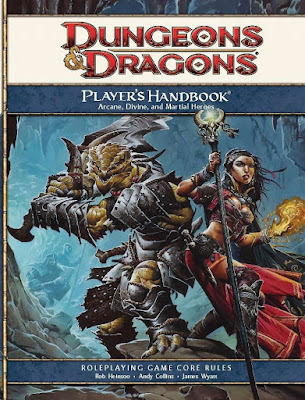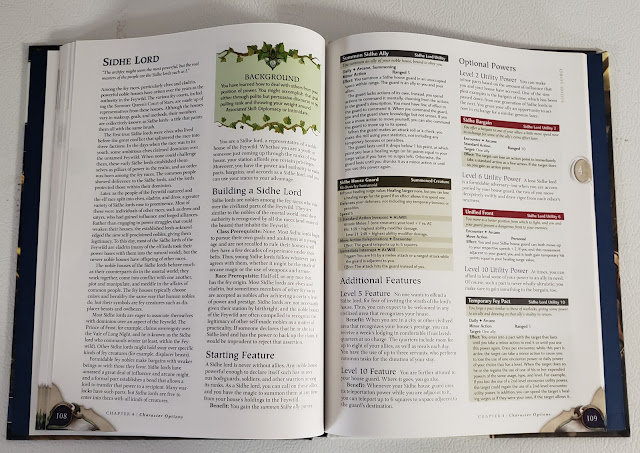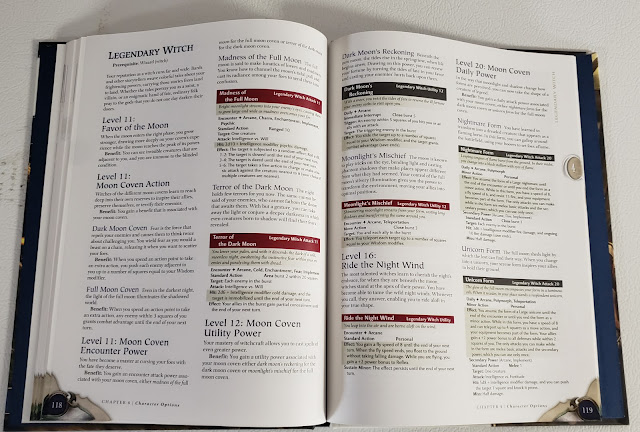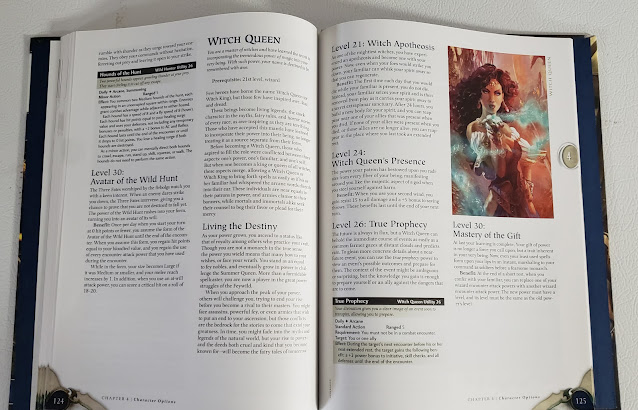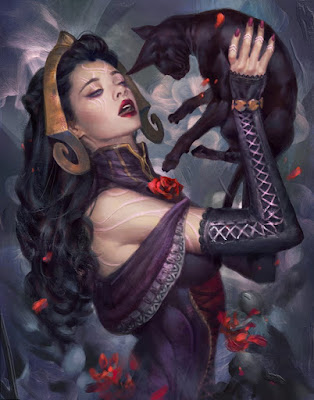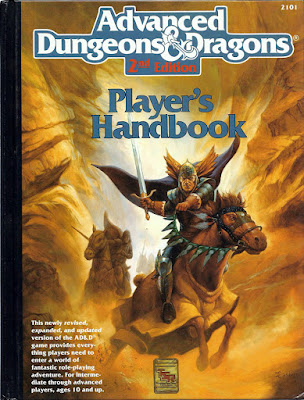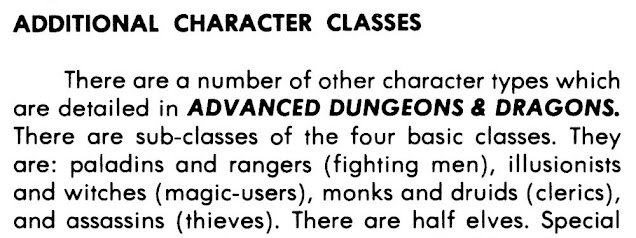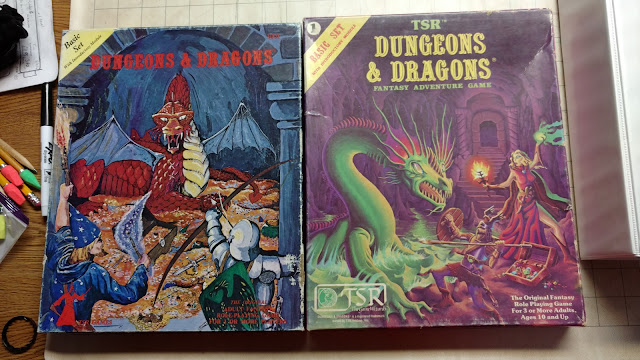Thursday's Children
 It is somewhen in the nineteenth century… It is the dawning of a new age, yet the relationships of the past age linger… For centuries, the peoples of Scandinavia have lived side by side with the Vaesen, supernatural creatures who helped out on the farms, gave a hand when it came to calving, ensured that lost children would find their way home, and kept everyone alive during the harsh winters of Northern Europe, and in return would receive milk and grain from the farms. As Scandinavia is changed by war and industrialisation and revolution and urbanisation and migration and sciences, the once symbiotic relationship between the people and the vaesen has been driven asunder. The ways of the country have been forgotten, few knowing how to appease the vaesen, and in turn the vaesen have turned aggressive, bloodthirsty, and wicked—snatching children where they once would have kept a watch over them, wrecking houses when once they would have swept them clean, and burning barns when once they would have driven out the vermin. In their wrath, they grow stronger and volatile, and the supernatural seems to spread as streams run with blood, calves are born with two heads, children are lost in the forests, and faeries skip into villages to lure the young maid and the handsome man away with them. The vaesen—Mermaids and Wood Wives, Werewolves and Witches, Revenants and Mylings, Sea Serpents and Kraken, and more, have become a threat and for the good of all, a solution must be found to their pernicious activities!
It is somewhen in the nineteenth century… It is the dawning of a new age, yet the relationships of the past age linger… For centuries, the peoples of Scandinavia have lived side by side with the Vaesen, supernatural creatures who helped out on the farms, gave a hand when it came to calving, ensured that lost children would find their way home, and kept everyone alive during the harsh winters of Northern Europe, and in return would receive milk and grain from the farms. As Scandinavia is changed by war and industrialisation and revolution and urbanisation and migration and sciences, the once symbiotic relationship between the people and the vaesen has been driven asunder. The ways of the country have been forgotten, few knowing how to appease the vaesen, and in turn the vaesen have turned aggressive, bloodthirsty, and wicked—snatching children where they once would have kept a watch over them, wrecking houses when once they would have swept them clean, and burning barns when once they would have driven out the vermin. In their wrath, they grow stronger and volatile, and the supernatural seems to spread as streams run with blood, calves are born with two heads, children are lost in the forests, and faeries skip into villages to lure the young maid and the handsome man away with them. The vaesen—Mermaids and Wood Wives, Werewolves and Witches, Revenants and Mylings, Sea Serpents and Kraken, and more, have become a threat and for the good of all, a solution must be found to their pernicious activities!Yet there are those who have not forgotten the vaesen. In fact, it was an encounter with vaesen, perhaps a werewolf under the full moon or a troll under that bridge, which gave them the gift of the Sight, the ability to see vaesen, and made them each a Thursday’s Child. Some of those with the Sight have gathered at the headquarters of the Society, the old and decaying Castle Gyllencreutz by the Fyris River in Upsala, a city noted for the size of its Gothic cathedral and power of the Church, its large university, and recent which devastated much of the city. The Society was a body of men and women which for centuries had dedicated itself to the study and understanding of the vaesen, whose last members have been missing or resigned for at least a decade. As members of the newly re-established Society, they will travel across Scandinavia, seeking out vaesen, not to hunt them or take them as trophies, but to understand them and to help them, so that they will stop preying upon the peoples of Scandinavia. It is not a matter of taking force of arms to stop the vaesen, but to research them, to identify their weakness, and to use it against them. And despite their courage, conviction, and ability to see the supernatural, this is not without its dangers for members of the Society. Exposure to and confrontation with the vaesen and their strange abilities and the secrets of Scandinavia, will scar members of the Society, perhaps even permanently. However, duty and the lure of understanding will drive members of the Society to confront the vaesen for as long as they are able…
This is the set-up for Vaesen – Nordic Horror Roleplaying, a roleplaying game of investigative folklore horror set in nineteenth century Scandinavia, based on Vaesen: Spirits and Monsters of Scandinavian Folklore as collected and illustrated by Johan Egerkrans, and published by Free League Publishing. It is an investigative horror game set in Scandinavia during the nineteenth century, using the Year Zero engine first seen in Mutant: Year Zero – Roleplaying at the End of Days, and subsequently a wide array of roleplaying games from Tales from the Loop – Roleplaying in the '80s That Never Was to Forbidden Lands – Raiders & Rogues in a Cursed World. Although suitable for oneshot scenarios, Vaesen – Nordic Horror Roleplaying is designed for campaign, the Player Characters expected to return from their investigations into the vaesen to Castle Gyllencreutz where they have the chance to recover from and ruminate on their encounters and discoveries, explore the castle and perhaps uncover its secrets and facilities, make friends and allies in the community at large, and hopefully ward off the unwanted attention and intrusion of the curious, the superstitious, and the sceptical… To that end, Vaesen – Nordic Horror Roleplaying provides the means to create characters, investigate and confront the vaesen, develop and explore Castle Gyllencreutz, details of the various types of vaesen with some twenty or so fully described, advice for the Game Master, and ‘The Dance of Dreams’, a complete introductory mystery.
A Player Character in Vaesen – Nordic Horror Roleplaying is defined by his age; Attributes and Skills; a Motivation, a Trauma, and a Dark Secret; a Talent and a relationship with another Player Character, a memento, and some equipment. Age sets the balance between Attributes and Skills, the Attributes of Physique, Precision, Logic, and Empathy being rated between two and five, Skills between one and five; Motivation explains why the Player Character is prepared to hunt down and confront vaesen, whilst Trauma explains why or how the Player Character gained the Sight; and the Dark Secret is something that the Player Character wants to keep. Each Talent is a trick or trait, such as Bookworm which provides a bonus to the Learning Skill or Nine Lives, which enables a player to switch the dice when rolling to determine what critical injury his character suffers. Talents are either tied to a particular Archetype or general, in which case, any character can select them later on in the game. A Memento is a possession which the Player Character holds dear, such as a dried red rose or a golden box from a distant land, and by interacting with it, help him overcome a Condition.
To create a character, a player has two options. The first is to choose an Archetype of which there are ten—Academic, Doctor, Hunter, Occultist, Officer, Priest, Private Detective, Servant, Vagabond, and Writer. Each provides options for the player to choose from in terms of Names, Motivation, Trauma, Dark Secret, and Relationships, and lists the Archetype’s main Attribute and Skill, and suggested Talents and Equipment. The player also assigns points to his Attributes and Skills.
Our first sample character is Selma Nilsson, a middle-aged women who always wanted to be a writer, but her ambitions were thwarted by having to look after her sick mother, who also frowned on her desire to tell stories. Unable to complete any stories due to her mother’s influence, it was a great shock to discover upon her mother’s death that her mother had written stories herself. Not long after Selma published the first few of them, she was visited by a strange creature who cursed her for stealing its stories… And now she cannot complete any stories!
Name: Selma Nilsson
Age: Middle-Aged
Motivation: Revenge
Trauma: Cursed by a homeless vaettir to write a book in your own blood
Dark Secret: My life’s work is a lie
Relationship: Tries to win your appreciation (Doctor)
Physique 2
Precision 3
Logic 4
Empathy 5
Talent: Automatic Writing
Skills
Agility 0, Close Combat 0, Force 0, Inspiration 3, Investigation 0, Learning 2, Manipulation 1, Medicine 2, Observation 2, Ranged Combat 0, Stealth 0, Vigilance 2
Equipment: Writing utensils and paper, camera, pet dog
Memento: Gold jewellery worn by your mother
The other option is to create a character using the Background tables at the rear of the book. This covers everything from a Player Character’s Class, Upbringing, Profession—which determines his Archetype, to life events which can be rolled numerous times, aging the Player Character in the process. Both options are quick, but the Background tables add flavour and detail lacking in the simple method of picking an Archetype.
Our second sample character then is Oskar Dolk, a Vagabond whose strange capture and subsequent escape from a troll bag ultimately led him to the doors of Castle Gyllencreutz. Oskar Dolk is not his real name, but that of a fellow prisoner who Rolf served part of his sentence with. Rolf’s family were servants to the nobility, much put upon and unhappy in their lot, and after one too many beatings, he ran away and was captured by the troll. When he escaped and made his way home, his masters beat him some more and banished him from his former home. Forced to live on the road, he was first arrested for vagrancy, and then accused and imprisoned for theft. He later escaped, finding refuge with a former cellmate, Oskar Dolk, and when he died the next winter taking his identity.
Name: Oskar Dolk (Rolf Krabbe)
Age: Young
Class: Poor
Upbringing: Servant
Profession: Day Labourer
Motivation: Being liked
Trauma: Survived a week inside a troll bag
Dark Secret: Stolen identity
Relationship: Feigned gratitude (Hunter)
Life Events: Prison
Resources: 1
Physique 5
Precision 4
Logic 3
Empathy 3
Talent: Hobo Tricks
Skills
Agility 1, Close Combat 1, Force 1, Inspiration 0, Investigation 0, Learning 0, Manipulation 3, Medicine 0, Observation 2, Ranged Combat 0, Stealth 1, Vigilance 1
Equipment: Walking stick, knife, liquor, lockpicks
Memento: A scruffy cat
Mechanically, Vaesen – Nordic Horror Roleplaying uses the Year Zero engine, Free League Publishing’s house rules, which uses pools of six-sided dice. Vaesen – Nordic Horror Roleplaying uses a simpler version than first seen in Mutant: Year Zero – Roleplaying at the End of Days—so not Base (or Attribute) dice, Skill dice, and Gear dice, but simply Attribute and Skill dice, plus whatever bonus or penalty dice the Game Master awards, such as from the situation or a Talent. For a character to undertake an action, his player rolls dice equal to the character’s Attribute and Skill appropriate for that action. To succeed, all he needs to roll is typically one Success or six—though sometimes it may be more—on any of the dice. Extra Successes can be expended to gain various effects, such as gaining bonuses to further skill tests where the information will be useful in Observation tests or increase damage or inflict stress upon an enemy with Ranged Combat.
Where the Year Zero engine and Vaesen – Nordic Horror Roleplaying gets interesting is that if a player fails a roll, he can reroll or Push the test. A player rerolls everything bar the Successes already rolled to get more. In other iterations of the Year Zero engine, such as Mutant: Year Zero – Roleplaying at the End of Days and Forbidden Lands – Raiders & Rogues in a Cursed World, rolls of one in both the original roll and the pushed roll are kept and have negative effects upon the character, typically reducing temporarily, the Attribute used in the roll or damaging the item of equipment used. Vaesen – Nordic Horror Roleplaying does not use that mechanic and so there is not the degradation of Attributes or equipment as there are in those games. Instead, the character suffers a Condition if forced to Push a roll, the nature of the Condition depending upon if the action was physical or mental. So Exhausted, Battered, and Wounded are physical Conditions, whilst Angry, Frightened, and Hopeless are mental Conditions. The Condition only comes into effect after the dice roll has been made and its success or failure been determined. Each Condition of the same type reduces the number of dice rolled for the associated type of action and if a character acquires four Conditions of the same type, then he is Broken and cannot undertake any actions of that type.
For example, Oskar Dolk believes that the flop house he is staying in is haunted and the landlady knows what is causing it—he has determined that she is meeting something down in the cellar. He decides to creep down the stairs and spy on what is going on—this is what Oskar’s player states that his aim will be. The landlady has locked the cellar door behind her, but fortunately, Oskar has the late Rolf’s set of lockpicks. The Game Master sets the difficulty at one and Oskar’s player assembles the dice pool of five dice from his Precision Attribute and Stealth Skill. He rolls one, two, four, five, and five—so no Successes. His player decides to Push and pick up all of the dice again and rerolls them, this time rolling one, two four, five, and six, for one Success! However, Oskar also suffers a Condition, which will be a Physical one because Precision is a Physical Attribute. The Game Master selects Exhausted for him and suggests that he has not getting enough sleep and until Oskar addresses the Condition, his player will roll one less die on all physical tests.Combat in Vaesen – Nordic Horror Roleplaying uses the same core mechanics, but adds tweaks to both initiative and actions. Initiative is handled by both players and Game Master drawing from a ten-card deck, numbered one to ten. Initiative then proceeds in ascending order, though some Talent allow Initiative to be changed and players can swap initiative cards if one character needs to act before another. Otherwise it remains the same throughout a fight. In combat itself, a character can perform two actions—a Fast Action and a Slow Action. The first might be a dodge, a parry, a swing of a heavy weapon before an actual attack with a heavy weapon, run, aim, and so on, whereas the second might be a slash with an edged weapon, stab with a pointed weapon, a taunt or persuade attempt, and so on. Fast Actions typically do not require dice rolls, whereas Slow Actions typically do.
One major change to the Year Zero engine is that damage suffered in combat does not directly degrade a character’s Attributes. Instead, it inflicts further Conditions, and once a character has suffered four Conditions of one type—Physical or Mental—and is Broken, he also suffers a Critical Injury, which is rolled randomly. Tables are provided for both Mental and Physical Critical Injuries, and can be defects or insights, as well as potentially fatal. So for example, a Physical Critical Injury might be a Knee injury, a defect which causes a skewed walk and reduces the character’s Agility skill by one, whereas a Coma grants the insight of Prophetic Vision for up to six days and a bonus to the Investigation skill. When the character returns to his headquarters, he has the choice to heal both defects and insights suffered or make them permanent.
Vaesen – Nordic Horror Roleplaying is a horror game and so has a Fear mechanic. This is either an Empathy or Logic test rolled against the Fear value of the Vaesen or the situation being faced. For example, a terrible situation such as encountering a werewolf or discovering the corpse of a child, has a Fear value of two and this is the number of a Successes a player must roll to avoid becoming Terrified. If this happens, a character suffers Conditions equal to the Fear value and must either flee, freeze, faint, or attack—the player’s choice. Like the rest of the mechanics in Vaesen – Nordic Horror Roleplaying, the Fear mechanic is simple, fast, and effective, as well as enforcing the fact investigating the vaesen is a collective endeavour—bonus dice are awarded for the number of characters present when a Fear test has to be made.
There is also a sense of the collective when it comes to the most immediate element of the setting for the Player Characters, the crumbling Castle Gyllencreutz, the headquarters of the Society in the city of Upsala. There a sense of mystery to the place, with doors locked and keys missing and sections closed up, but the Player Characters have the opportunity to improve the castle each time they return home from solving a mystery. Here there is a marked difference between Mutant: Year Zero – Roleplaying at the End of Days and Vaesen – Nordic Horror Roleplaying. At the end of each session or scenario in both roleplaying games, the Game Master asks questions of his players, such as “Did you play in the session?”, “Did you go somewhere new?”, and so on, and for each positive answer, a Player Character earns a Development Point. In Mutant: Year Zero – Roleplaying at the End of Days, the Player Characters invest their time and skill in improving their community—their ark—but in Vaesen – Nordic Horror Roleplaying, the Player Characters invest Development Points, which might otherwise be expended to improve Skills and Talents. As a consequence, there are more questions to be asked and potentially, the Player Characters can earn more of them. Upgrades to Castle Gyllencreutz come in the form of facilities, such as Butterfly House and Séance Parlour, Contacts, from Banker to Psychiatrist, and Personnel, from the Butler Algot Frisk (he more or less comes with the castle though) and Stable Boy.
There is a delightful scope for roleplaying in this aspect of Vaesen – Nordic Horror Roleplaying. The connections to the Contacts and Personnel can of course be roleplayed, but so can the Facilities. Essentially, the Player Characters do not so much simply purchase them, but they might find them behind a hidden door or find the key to a locked door, and so be restoring them rather than simply building them. There is a potential downside to every upgrade though, in that the growing Society can be faced with Threat, which is rolled for, such as a Journalist intent on exposing the Player Characters’ secrets at any cost or a bank clerk who comes to collect on an old debt connected to the castle’s previous owner, providing further opportunities for roleplaying.
The history of the Society is given in some detail, from the involvement of the young scientist Carl Linnaeus through to its relatively recent dissipation and refounding by the Player Characters. Beyond the Society, Upsala is explored in some detail, taking in its high points and low points, from Upsala University Hospital—the most modern in Sweden, and Upsala Botanical Garden of Upsala University to the Poorhouse and Wellspring Street 59 ( a highly disreputable brothel). In comparison, the Mythic North is explored in broader detail, taking in Sweden, Norway, Finland, and Denmark, the social upheavals which wrack the region throughout the nineteenth century, such as between country and city, science and faith, and so on. There is very much an ahistorical feel to the background, which lets the Game Master set her campaign at any time throughout the nineteenth century.
At the centre of Vaesen – Nordic Horror Roleplaying are the vaesen themselves. This covers their nature in general, but not necessarily defining ‘exactly’ what they are, simply categorising them into five broad types—nature spirits, familiars, shapeshifters, spirits of the dead, and monsters. Their magic is also presented—Enchantments (animals being born with defects or terrible storms), Curses (inflicting a sense of self-loathing or making someone lame), and Trollcraft (altering age or transforming victims into animals), all powerful, but clearly stated as being story tools rather than means of eliminating the Player Characters. It is possible for Player Characters to learn magic, but each spell or cure is treated as an individual skill and cannot be simply studied. Vaesen are simply defined, and mechanically, their actions are decided by the Game Master to suit the narrative rather than her rolling the dice. Similarly, the Player Characters do not test their skills defeat or banish any one vaesen. Instead their players describe what they do. If it matches the criteria, then the attempt to banish the vaesen automatically succeeds. The conflict here lies in discovering what the means of banishment actually is, protecting or defeating those persons who have fallen under the vaesen’s sway, making the preparations, keeping the vaesen from attacking them, and so on.
Each of the twenty-one vaesen in Vaesen – Nordic Horror Roleplaying, from the Ash Tree Wife, Brook Horse, and Church Grim to the Werewolf, Will-o’-the-Wisp, and Wood Wife, is given a two-page spread. Along with some flavour text and a description, this lists its magical powers, the Conditions it suffers if the Player Characters do manage to hurt it, the ritual required to banish it, and a trio of example conflicts, essentially each one a scenario hook the Game Master can develop into a fuller mystery. This is in addition to hooks scattered throughout the book. As a side note, Vaesen – Nordic Horror Roleplaying looks at vaesen around the world, so that although no stats are given, a Game Master could set her campaign elsewhere other than the Mythic North with some effort. The write-ups of the vaesen are accompanied by an excellent guide to what makes up a mystery—atmosphere, clues, locations, the conflicts at the heart of the mystery, and so on, plus its structure and advice for the Game Master. The structure is broken down into a series of eight steps, from the prologue where the Player Characters can have a scene each in Upsala and an Invitation which gives them the reason to go to the country location where a vaesen is proving to be a problem, to the confrontation with the vaesen and its aftermath. Along with the good advice for Game Master, this is a solid chapter, and it even comes with suggestions as to how to make each mystery and a campaign, more like traditional fairy tales.
Rounding out Vaesen – Nordic Horror Roleplaying is ‘The Dance of Dreams’, a short mystery designed to start a campaign. It is a nice little haunting tale tied back into the history of the Society and its secrets, whilst also laying the foundation for scenarios and content to come.
Physically, Vaesen – Nordic Horror Roleplaying is simply lovely. It is richly illustrated by Johan Egerkrans, drawing on his Vaesen: Spirits and Monsters of Scandinavian Folklore, and gives the roleplaying game a consistently singular look throughout. The book is very well written, being engaging and easy to read throughout. The book also feels good in the hand, with a tactile cover and off-white pages which give it the look of a period tome.
There can be no doubt that Vaesen – Nordic Horror Roleplaying is a beautiful book, there being something mythical, almost lyrical and fairy tale-like in Johan Egerkrans’ artwork. It sets the tone and style for the roleplaying game, whose tried and trusted Year Zero mechanics have been tweaked to support its ‘monster-mystery’ style of play—a style of play that ultimately emphasises brains over brawn. Vaesen – Nordic Horror Roleplaying is a superb horror roleplaying game, one which takes a different take upon the genre and a different take upon the period, and one which begs to be played.







